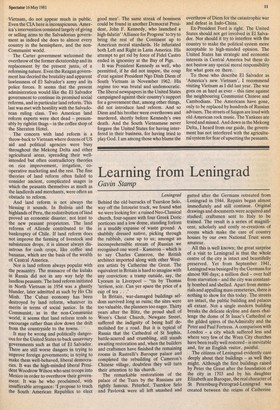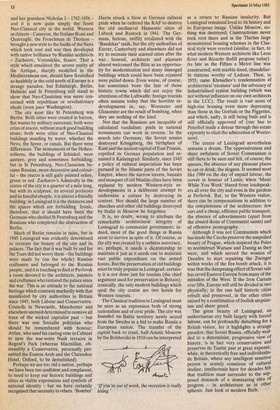Learning from Leningrad
Gavin Stamp
Leningrad Behind the old barracks of Tsarskoe Selo, way off the Intourist track, we found what we were looking for: a ruined Neo-Classical church, four-square with four Greek Doric porticoes and a low dome, standing forlorn in a muddy expanse of waste ground. A shabbily dressed native, picking through the rubbish, came up to us; amongst an incomprehensible stream of \Russian we recognised one word — Kameron — which is to say Charles Cameron, the British architect imported along with other Western artists by Catherine the Great. The equivalent in Britain is hard to imagine with any conviction: a tramp outside, say, the Lyceum in Liverpool — "tis by Thomas 'arrison, soir. Can yer spare the price of a cup of tea . In Britain, war-damaged buildings seldom survived long as ruins; the sites were too valuable, the planners too eager. Thirty years after the Blitz, the proud shell of Wren's Christ Church, Newgate Street, suffered the indignity of being half demolished for a road. But it is typical of Russia that the Cathedral of St Sophia, battle-scarred and crumbling, still stands awaiting restoration and, when the builders and craftsmen have finished the remaining rooms in Rastrelli's Baroque palace and completed the rebuilding of Cameron's Chinese village, doubtless they will turn their attention to his church.
The remarkable restorations of the palace of the Tsars by the Russians are rightly famous. Peterhof, Tsarskoe Selo and Pavlovsk were all left smashed and gutted after the Germans retreated from Leningrad in 1944. Repairs began almost immediately and still continue. Original drawings and documents were acquired and studied; craftsmen sent to Italy to be trained. The result is a series of magnificent, scholarly and costly re-creations of rooms which make the care of country houses by our own National Trust seem amateur.
All this is well known; the great surprise of a visit to Leningrad is that the whole centre of the city is intact and beautifully preserved. Yet from September 1941, Leningrad was besieged by the Germans for almost 900 days; a million died — over half from starvation — and the city was constantly bombed and shelled. Apart from memorials and appalling mass cemeteries, there is nothing to show for this today. The streets are intact, the public building and palaces all extant. Not a single modern building breaks the delicate skyline and dares challenge the dome of St Isaac's Cathedral or the gilded spires of theAdmiralty and the Peter and Paul Fortress. A comparison with London — a city which suffered less and where very few of the Wren City churches have been really well restored is inevitable and, for an English visitor, painful.
The citizens of Leningrad evidently care deeply about their buildings — as well they might. Although the first buildings raised by Peter the Great after the foundation of the city in 1703 and by his daughter Elizabeth are Baroque, the real character of St Petersburg-Petrograd-Leningrad was created between the reigns of Catherine and her grandson Nicholas I — 1762-1856 — and it is now quite simply the finest Neo-Classical city in the world. Western architects—Cameron, the Italians Rossi and Ouarenghi, the Frenchman de Thomon — brought a new style to the banks of the Neva which took root and was then developed with native brilliance by Russian architects Zacharov, Voronikhin, Stasov. That a style which emulated the severe purity of the Antique, sharply modelled in the Mediterranean sun, should have flourished so healthily in the cold north of Europe is a strange paradox, but Edinburgh, Berlin, Helsinki and St Petersburg still stand to show that Neo-Classicism was more concerned with republican or revolutionary ideals (even pace Washington).
The city most like St Petersburg was Berlin. Both cities were created in barren, flat wastes by military autocrats; both were cities of stucco, without much good building stone; both were cities of Neo-Classical buildings standing by water, whether the Neva, the Spree, or canals. But there were differences. The monuments of the Hohenzollerns, the buildings of Schinkel, were austere, grey and sometimes forbidding; but in St Petersburg, Neo-Classicism became Russian, more decorative and colourful — the stucco is still gaily painted ochre, green or red. Zacharov's Admiralty in the centre of the city is a quarter of a mile long, but with its sculpture, its several porticoes and its fanciful steeple, it is almost a friendly building: in Leningrad it is the distances and the spaces which are forbidding. Ironic, therefore, that it should have been the Germans who shelled St Petersburg and the Russians who completed the destruction of Berlin.
Much of Berlin remains in ruins, but in 1945 Leningrad was evidently determined to recreate the beauty of the city and its palaces. The fact that it was built by and for the Tsars did not worry them — the buildings were made by (on the whole) Russian craftsmen and belonged to the Russian people, and it is touching to find at Pavlovsk a room devoted to the architects, painters and craftsmen who restored the palace since the war. This is an attitude to the national heritage which contrasts markedly with that manifested by city authorities in Britain since 1945, both Labour and Conservative. Councils in Newcastle, Manchester and elsewhere seemed determined to remove all trace of the wicked capitalist past — but there was one Socialist politician who should be remembered with honour: Attlee, who used his casting vote in Cabinet to save the war-worn Nash terraces in Regent's Park (whereas Macmillan, ob stensibly a Conservative, personally permitted the Euston Arch and the Clarendon Hotel, Oxford, to be demolished).
Perhaps we are too old a nation, perhaps we have been too confident and complacent, to need to keep our historic buildings and cities as visible expressions and symbols of national identity — but we have certainly recognised that necessity in others. `Bomber' Harris struck a blow at German cultural pride when he ordered the RAF to destroy the old mediaeval Hanseatic cities of Liibeck and Rostock in 1941. The Germans, furious, swiftly retaliated with the 'Baedeker' raids, but the city authorities of Exeter, Canterbury and elsewhere did not try to recreate their scarred cities after the war. Instead, architects and planners almost welcomed the Blitz as an opportunity for modernisation and many damaged buildings which could have been repaired were pulled down. Even worse, of course, has sometimes been the fate of those historic towns which did not enjoy the attentions of the Luftwaffe: foreign tourists often assume today that the horrible redevelopments in, say, Worcester and Gloucester are the result of bombing, when they are nothing of the kind.
Not that the Russians are incapable of calculated vandalism: pride in national monuments can work in reverse. In the march into Germany, the Soviet armies destroyed Ktinigsberg, the birthplace of Kant and the ancient capital of East Prussia, expelled its German population and renamed it Kaliningrad. Similarly, since 1945 a policy of cultural imperialism has been pursued in the Islamic parts of the Soviet Empire, where the narrow streets, bazaars and mosques of old Muslim cities have been replaced by modern Western-style redevelopments in a deliberate attempt to undermine a culture by destroying its context. Nor should the large number of churches and other old buildings destroyed by Stalin in Moscow be forgotten.
It is, no doubt, wrong to attribute the remarkable architectural integrity of Leningrad to communist government: indeed, most of the good things in Russia seem to survive in spite of it. Of course, as the city was created by a ruthless autocracy, so, perhaps, it needs a dicatatorship to maintain it just as it needs one to maintain vast public expenditure on the armed forces. But the preservation of old buildings must be truly popular in Leningrad: certainly it is not done just for tourists (the chief argument used for preservation in Britain); ironically, the only modern buildings which spoil the city centre are two hotels for Western tourists.
The Classical tradition in Leningrad must be seen as an expression both of strong nationalism and of civic pride. The city was founded on Baltic territory newly seized from the Swedes in a bid to make Russia a European nation. The transfer of the capital back to cruel, half-Asiatic Moscow by the Bolsheviks in 1918 can be interpreted as a return to Russian insularity. But Leningrad remained loyal to its history and its European image. Unlike Moscow, nothing was destroyed; Constructivism never took root there and in the Thirties large monumental housing schemes in the Classical style were erected (similar, in fact, to what modern Western architects like Leon Krier and Ricardo Bofill propose today). As late as the Fifties a Metro line was constructed, with marble-lined, chandelierlit stations worthy of Ledoux. Then, in 1955, came Khruschev's condemnation of architectural 'excesses' and the advocacy of industrialised system building (which was not without influence on our own architects in the LCC). The result is vast acres of high-rise housing even more depressing than those in the Gorbals or the Piggeries, and which, sadly, is still being built and is still officially approved of (our bus to Peterhof made a detour through this estate expressly to elicit the admiration of Westerners).
The centre of Leningrad nevertheless remains a dream. The oppressiveness and sheer awfulness of Soviet Communism is still there to be seen and felt, of course; the queues, the absence of any pleasant places to eat or drink, the slogans. It seemed most like 1984 on the day of unpaid labour, the corvee in honour of Lenin, when 'Music While You Work' blared from loudspeakers all over the city and even in the gardens at Paylovsk. But, to the Western visitor, there can be compensations in addition to the completeness of the architecture: few cars and a cheap, efficient public transport, the absence of advertisments (apart from the absurd ikons of Communist saints) and of offensive pornography.
Although it was not Communism which has made the Czechs preserve the unspoiled beauty of Prague, which inspired the Poles to reconstruct Warsaw and Danzig as they were, and which moved the women of Dresden to start repairing the Zwinger within weeks of the fire-bomb attack, it is true that the dampening effect of Soviet rule has saved Eastern Europe from many of the mistakes of the West. If the Iron Curtain ever lifts, Europe will still be divided in two physically; in the one half historic cities rebuilt and preserved, in the other cities ruined by a combination of foolish utopianism and sheer greed.
The great beauty of Leningrad, an authoritarian city built largely with forced labour, can be profoundly disturbing for a British visitor, for it highlights a strange paradox: that Soviet Russia, officially wedded to a determinist, progressive view of history, is in fact very conservative and preserves its Tsarist past at great expense; while, in theoretically free and individualistic Britain, where any intelligent sensitive person is acutely conscious of cultural decline, intellectuals have for decades felt that tradition must surrender to the supposed demands of a dominating idea of progress — in architecture as in other spheres. Just look at modern Bath.











































 Previous page
Previous page